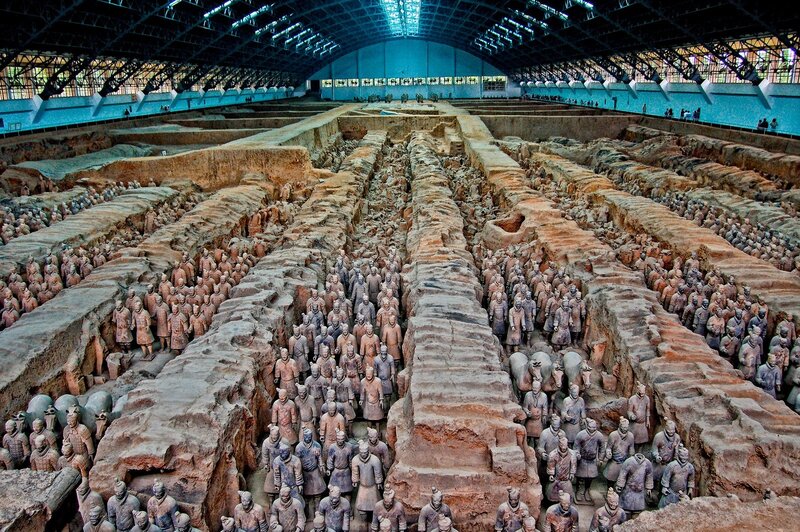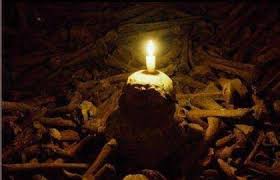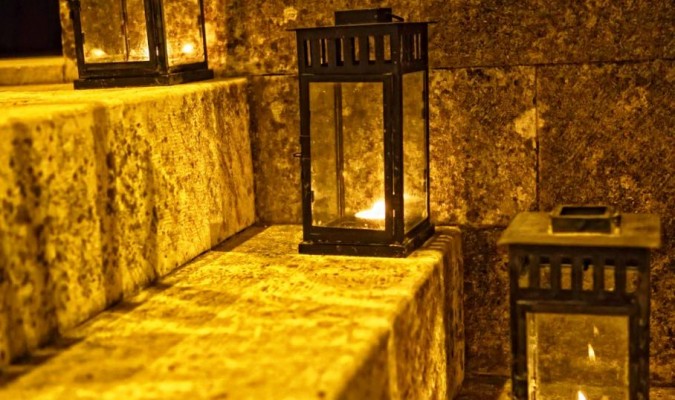Underground Masterpiece
Qin Shi Huang, the 36th ruler of the Qin Dynasty, ended the Warring States period by conquering six rival kingdoms and unifying China. During his reign, he constructed many grand projects, the most notable being the Great Wall of China and an extravagant underground mausoleum.
The construction of the mausoleum began in 246 BC when Qin Shi Huang was just 13 years old. After 38 years of relentless labor, involving an estimated 700,000 workers and artisans, the mausoleum was completed. Located at the foot of Mount Li in present-day Xi’an, Shaanxi Province, China, it is considered one of the most complex and large-scale ancient architectural sites in the world.

Construction of the mausoleum started in 246 BC when Qin Shi Huang was just 13 years old.
Eternal Light – A Mystifying Secret
One of the most prominent legends surrounding Qin Shi Huang’s mausoleum is the story of the “eternal” lamps. These lamps, believed to never extinguish, were placed within the tomb to protect the emperor’s eternal slumber. This phenomenon is not unique to Chinese culture, as similar tales exist in ancient Egyptian, Greek, and Roman civilizations.
According to historical records, the “Changming Deng” lamps were commonly used in the tombs of emperors and nobles. These lamps were specially designed to burn for extended periods, even in harsh conditions and enclosed environments.

One of the most prominent legends is the story of the “eternal” lamps.
Mysterious Tales
The captivating tales of eternal lamps are not merely confined to Chinese folklore. A Greek historian documented the existence of an unquenchable lamp within a temple dedicated to the sun in Egypt. Additionally, the Roman theologian Augustine made note of a lamp in the temple of Isis that remained aglow despite raging winds.
In 527 AD, a Roman military expedition stumbled upon a burning lamp in an ancient tomb. Records indicate that this lamp had been continuously lit for 500 years before its discovery. Similarly, in 1400, a lamp was found in the tomb of Pallas, son of the ancient Roman king Evandra, which was believed to have burned for over 2,000 years.
This phenomenon resurfaced in 16th-century England when King Henry VIII’s troops excavated a tomb and discovered a lamp still burning since 300 AD.
To this day, no scientifically convincing explanation exists for the eternal lamp phenomenon. A popular theory suggests that these lamps had a dual-layer structure: an inner chamber containing oil and a wick, while the outer chamber held water for cooling. While this design could prolong the lamp’s life, it couldn’t sustain the thousands of years as described in historical records.
In the 17th century, German chemist Hennig Brand proposed the theory that these lamps might have utilized phosphorus, a flammable substance capable of self-luminescence under certain conditions. However, the ability to maintain a flame for millennia remains controversial.
Another hypothesis suggests the use of fish oil, specifically whale or tuna oil, as the fuel source for these lamps. This type of oil burns slowly and has self-regenerating properties, but the harsh conditions within sealed tombs cast doubt on this theory as well.

To this day, the eternal lamp phenomenon remains a scientific mystery.
Mysteries of Qin Shi Huang’s Mausoleum
According to ancient records, Qin Shi Huang ordered the capture of a giant fish from the sea and used its fat to create oil for the lamps in his mausoleum. This oil was believed to possess self-regenerating properties, ensuring the eternal illumination of the lamps.
After more than three decades of research and hundreds of experiments, American chemist Simon Affik proposed a plausible hypothesis. He suggested that the lamps within the mausoleum were equipped with a special mixture of phosphorus and other combustible materials, capable of emitting light upon exposure to oxygen. According to this theory, when the tombs were opened, the increased oxygen levels ignited the lamps, giving the illusion that they had been burning for millennia.
However, Qin Shi Huang’s mausoleum remains largely unexplored. Archaeologists fear that opening the tomb could cause irreversible damage to its artifacts. Advanced technologies, such as ground-penetrating radar, have been employed to study the mausoleum’s structure without direct intervention.
One of the most remarkable discoveries within the mausoleum is the terracotta army, a massive and intricately detailed collection of statues. These figures have provided invaluable insights into the culture and art of the Qin Dynasty.
Mysteries Endure Through Time
Until archaeological technology makes significant advancements, the questions surrounding Qin Shi Huang’s mausoleum and the eternal lights will persist as one of history’s greatest enigmas. The immortal lamps, shrouded in mystery, stand as a testament to the ingenuity of ancient civilizations and a link between the present and distant memories.
The mausoleum of Qin Shi Huang, with its grandeur and enigma, awaits the opportune moment to unveil its secrets. When that time comes, it will undoubtedly spark curiosity and inspire humanity for generations to come.
The Majestic Mausoleum: A 54-Year Odyssey that Surpasses the Greatness of the Qin Emperor’s Eternal Resting Place
The Qin Shi Huang Mausoleum may be an architectural marvel, but prepare to be awe-struck by the Maoling Tomb. With its colossal scale and half-a-century-long construction, Maoling, the resting place of Han Wudi, is undoubtedly one of the most magnificent achievements in China’s rich historical tapestry.


































